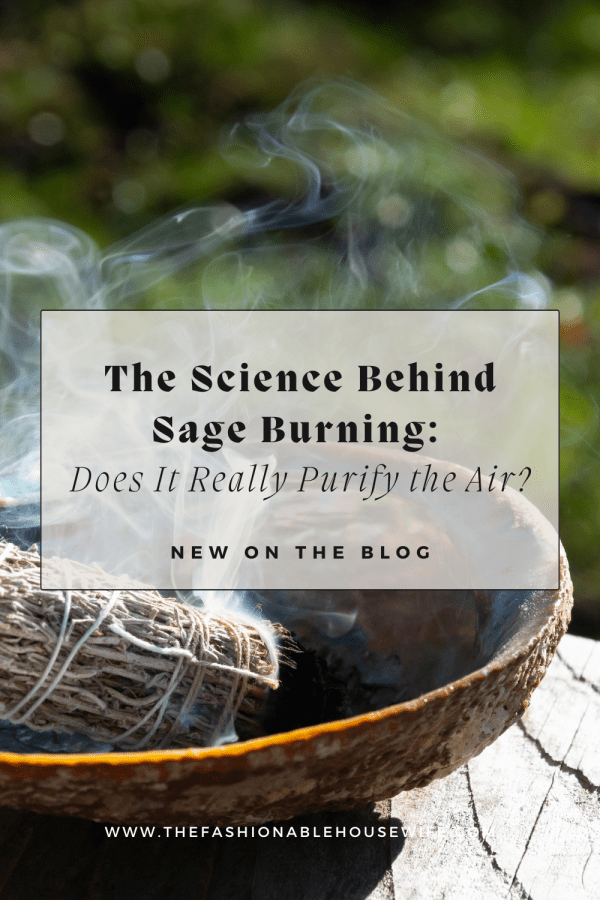The Science Behind Sage Burning: Does It Really Purify the Air?

Disclaimer: The views and opinions expressed in this article are those of the guest author and do not necessarily reflect the official policy or position of The Fashionable Housewife. Any content provided by our guest contributors is for informational purposes only and should not be considered a substitute for professional advice.
Sage burning, often referred to as smudging, is an ancient ritual practiced by various communities around the world for centuries. Many people embrace this practice, believing it can cleanse spaces of “negative energy”, promote healing, and purify the air.
And yet, curiosity about the actual science behind the claims remains. Does sage burning really purify the air, or is it more about tradition and belief? Let’s dive into the chemistry, studies, and tradition behind the benefits of white sage and sage burning as a whole.
The Origins of Sage Burning
Sage burning has roots in Native American culture, where smudging rituals involved lighting dried bundles of sage and wafting the smoke over people or spaces. Ancient Indigenous traditions used sage for spiritual cleansing, healing ceremonies, and protection against negative forces. White sage, specifically, was revered for its potent properties and used extensively in purification rituals.
Over the years, this practice has transcended borders and cultural limitations, becoming a staple in modern wellness circles. From removing “bad vibes” to addressing air quality, sage benefits burning proponents claim it has both spiritual and physical advantages. But what underpins these claims biologically and historically?
What Happens When You Burn Sage?
When sage burns, it releases smoke containing volatile compounds. Scientists have discovered that white sage, in particular, contains an array of bioactive chemicals and essential oils. These compounds contribute to its purported antimicrobial properties, which might explain why sage burning is believed to purify air.
Among the active components found in sage smoke are cineole and salvia compounds, which have been linked to antibacterial functions. These volatile compounds are thought to latch onto bacteria and airborne pollutants, potentially reducing indoor air contaminants. This is why many proponents argue that the benefits of white sage extend to air purification. (Read more about sage here.)

Benefits of White Sage in Smudging Practices
Air Purification
As mentioned above, burning sage may have microbial-cleansing properties. While further research is needed, studies suggest that burning sage could serve as a natural alternative to air purifiers for reducing harmful bacteria and other pathogens.
Spiritual Cleansing
Beyond its air-purifying benefits, many users turn to white sage for spiritual reasons. Smudging is thought to clear a space of negative energies or restore balance. Even skeptics often find the act of burning sage meditative, calming, and ceremonial.
*If you are Christian and wondering can a Catholic sage their house, read this post.
Mood and Mental Focus
Burning sage has been shown to release negative ions. These ions are believed to boost serotonin levels, which can help stabilize mood, reduce stress, and enhance focus. If you’ve ever lit white sage just before meditation, you may have noticed a sense of clarity and calmness.
Odor Elimination
Another overlooked benefit of white sage is its ability to neutralize unpleasant smells. The unique smoke produced has an earthy, clean aroma that can mask cooking odors, pet smells, and more.

Is Sage Burning Backed by Science?
While burning white sage is often celebrated in wellness communities, its scientific backing remains limited. Beyond studies about antimicrobial properties, there isn’t widespread evidence affirming all the claims about energy cleansing or mood enhancement. Much of what drives people toward lighting sage is anecdotal or connected to spiritual beliefs.
However, the growing interest in holistic remedies has led scientists to further investigate the benefits of white sage. Some early findings align with traditional claims, while others fall more into subjective interpretations of sage’s effects.
How to Burn Sage Effectively
If you’re interested in trying this ritual, follow these steps to ensure it’s done safely and effectively:
Start With Quality Sage
White sage is the most popular choice for rituals, but make sure it’s ethically sourced. Overharvesting white sage has become an environmental issue, so look for sustainable suppliers of smudge kits.
Prepare Your Space
Before burning sage, open windows and doors to ensure proper ventilation and allow negative energy (or smoke) to exit.
Light the Sage
Light the tip of your sage bundle until it begins to smolder. Blow gently on the flame and hold a fireproof dish under it to catch ash.
Diffuse the Smoke
Use slow, sweeping motions to direct the smoke throughout your space. If you’re smudging an individual, waft the smoke around them in circular motions.
Safely Extinguish
Never leave burning sage unattended. Once finished, press the burning tip into sand or a fireproof surface to ensure safe extinguishing.

Potential Downsides of Sage Burning
While burning white sage has several purported benefits, it’s worth noting potential drawbacks:
Allergies or Sensitivities
Smoke from burning sage can irritate respiratory systems in sensitive individuals, especially those with asthma.
Overuse of Ritual
Some critics warn that modern practitioners may overlook the cultural significance tied to lighting sage, potentially leading to cultural appropriation. It’s essential to honor and respect the roots of smudging traditions.
Environmental Impact
White sage has been overharvested in recent years due to its popularity. Unsustainable practices threaten the survival of this sacred plant. When purchasing sage bundles, prioritize ethically harvested options.
The Verdict: Does Sage Burning Purify the Air?
Sage burning does appear to have some evidence-based benefits when it comes to air purification, microbial-cleansing properties, and mood enhancement. The benefits of white sage, however, are most deeply rooted in spiritual and traditional practices rather than hard science. While its smoke may reduce airborne bacteria to an extent, it’s unlikely to replace clean air solutions or medical-grade disinfectants.
That said, burning sage combines ritualistic cleansing with potential health benefits, making it a powerful multi-purpose practice. Whether you light sage for spiritual reasons, energy cleansing, or odor control, many find its act therapeutic and rewarding.
Incorporating Sage Burning Into Daily Life
For those interested in holistic wellness, sage burning can be both a symbolic and practical tool. Here are a few ways to incorporate sage benefits burning into your daily life:
- Morning Energy Cleanse: Begin your day by burning sage to set intentions and energize your space.
- Post-Event Ritual: After hosting a party, burn sage to refresh your home and eliminate lingering odors.
- Meditative Practice: Pair sage with meditation or yoga sessions for enhanced focus.
Burning sage may never fully transition from tradition to mainstream science, but that doesn’t make it any less valuable for those who benefit from its practice. The combination of rituals, potential antimicrobial properties, and sensory effects solidifies white sage’s place in wellness spaces. (For more tips about improving your physical and mental well-being, visit this blog)

